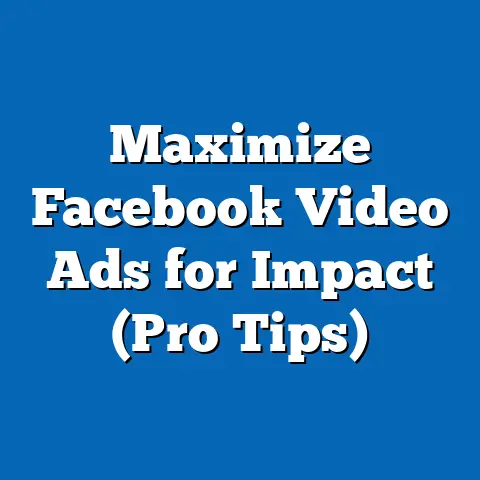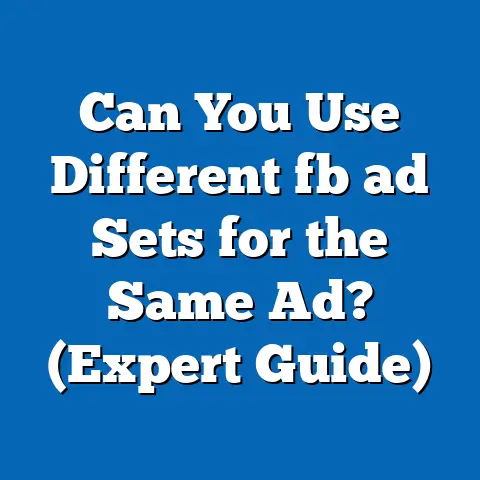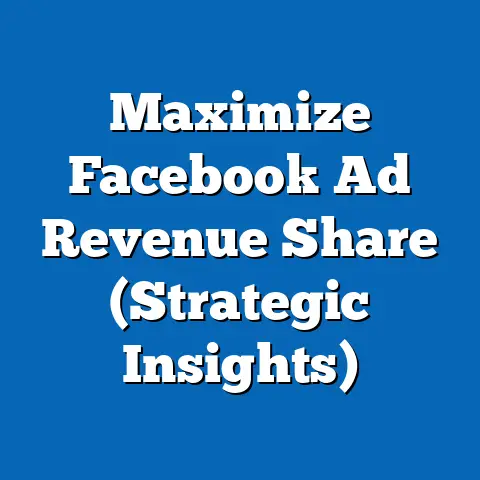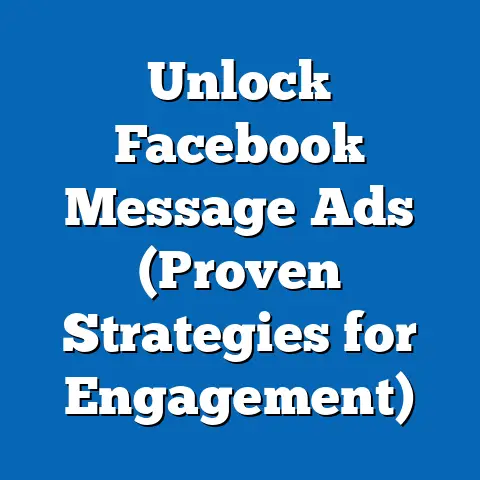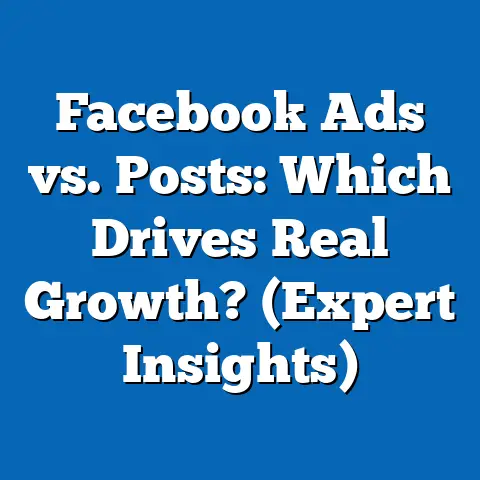Unlock the Right Facebook Ads Budget (Strategic Insights)
Unlock the Right Facebook Ads Budget: Strategic Insights
Have you ever felt overwhelmed by the seemingly endless options when it comes to budgeting for Facebook ads? I know I have, especially when I first started. It’s like navigating a maze, but trust me, with the right strategies, you can find your way to success.
Introduction: The Power of Facebook Ads
Facebook advertising has transformed the digital marketing landscape. With billions of active users, Facebook provides an unparalleled opportunity for businesses of all sizes to connect with potential customers. I’ve seen local businesses skyrocket their sales and global brands amplify their reach, all thanks to the power of targeted Facebook ads.
However, simply throwing money at Facebook isn’t enough. The key to a successful campaign lies in strategic budgeting. Determining the right budget is crucial for maximizing your return on investment (ROI) and achieving your advertising goals. Think of it as planting seeds – you need to invest wisely to reap a bountiful harvest.
In this guide, I’ll walk you through the essentials of Facebook Ads budgeting, sharing practical tips and insights I’ve gained over the years. Whether you’re a beginner just starting out or an experienced marketer looking to refine your strategy, this article will provide you with the knowledge and tools you need to unlock the right budget for your Facebook Ads campaigns.
1. Understanding Facebook Ads Budget Basics
Let’s start with the fundamentals. What exactly is a Facebook Ads budget, and how does it work?
What is a Facebook Ads Budget?
A Facebook Ads budget is the amount of money you allocate to spend on your advertising campaigns over a specific period. It’s the financial engine that powers your ads, determining how many people you can reach and how often your ads are displayed.
Daily vs. Lifetime Budgets
Facebook offers two primary budgeting options: daily and lifetime.
-
Daily Budget: This is the average amount you’re willing to spend on your ad set each day. Facebook will attempt to spend this amount daily, although it may fluctuate slightly depending on performance. For example, if you set a daily budget of $20, Facebook will aim to spend around $20 each day, but it might spend $18 one day and $22 the next.
-
Lifetime Budget: This is the total amount you’re willing to spend on your ad set over its entire duration. Facebook will distribute your budget evenly over the specified period. For instance, if you set a lifetime budget of $500 for a campaign running for 10 days, Facebook will aim to spend approximately $50 per day.
Daily Budget: This is the average amount you’re willing to spend on your ad set each day. Facebook will attempt to spend this amount daily, although it may fluctuate slightly depending on performance. For example, if you set a daily budget of $20, Facebook will aim to spend around $20 each day, but it might spend $18 one day and $22 the next.
Lifetime Budget: This is the total amount you’re willing to spend on your ad set over its entire duration. Facebook will distribute your budget evenly over the specified period. For instance, if you set a lifetime budget of $500 for a campaign running for 10 days, Facebook will aim to spend approximately $50 per day.
I’ve found that daily budgets are excellent for ongoing campaigns that require constant monitoring and adjustments, while lifetime budgets work well for campaigns with a fixed duration, such as promoting a specific event or product launch.
Setting Clear Goals
Before you even think about numbers, it’s crucial to define your advertising goals. What do you want to achieve with your Facebook Ads? Are you aiming to:
- Increase brand awareness?
- Generate leads?
- Drive sales?
- Increase website traffic?
Your goals will directly influence your budget. For example, a brand awareness campaign might require a larger budget to reach a wider audience, while a lead generation campaign can often be more targeted and cost-effective.
Bidding Strategies
Bidding strategies determine how Facebook optimizes your ad delivery and spends your budget. Common bidding strategies include:
- Cost-Per-Click (CPC): You pay each time someone clicks on your ad.
- Cost-Per-Impression (CPM): You pay for every 1,000 impressions (times your ad is shown).
- Cost-Per-Action (CPA): You pay when someone takes a specific action, such as making a purchase or filling out a form.
The bidding strategy you choose will impact how your budget is spent. For instance, a CPC strategy is ideal if you’re focused on driving traffic to your website, while a CPM strategy might be better for brand awareness campaigns.
Key Takeaway: Before diving into specific budget numbers, understand the basics of daily vs. lifetime budgets, define your advertising goals, and choose the right bidding strategy to align with your objectives.
2. Factors Influencing Your Facebook Ads Budget
Now that we’ve covered the basics, let’s explore the key factors that influence your Facebook Ads budget. Understanding these factors will help you make informed decisions and avoid common pitfalls.
Target Audience Size and Demographics
The size and characteristics of your target audience play a significant role in determining your budget. A larger audience generally requires a larger budget to reach effectively. Similarly, targeting specific demographics (e.g., age, gender, location, interests) can impact costs.
For example, if you’re targeting a niche audience with very specific interests, the cost per impression (CPM) might be higher due to increased competition. On the other hand, if you’re targeting a broad audience, you might need a larger budget to reach enough people to achieve your goals.
Industry Competition
The level of competition in your industry also affects your Facebook Ads budget. Highly competitive industries often have higher advertising costs due to increased demand for ad placements.
I’ve seen this firsthand when working with clients in the e-commerce space. During peak shopping seasons like Black Friday and Cyber Monday, advertising costs tend to skyrocket due to intense competition.
To combat this, it’s essential to research your competitors and understand their advertising strategies. Use tools like Facebook Ad Library to analyze their ads and identify opportunities to differentiate your messaging and targeting.
Seasonality and Timing
Seasonality and timing can significantly impact your Facebook Ads budget. Certain times of the year, such as holidays and events, often see increased advertising costs due to higher demand.
For example, if you’re running a campaign to promote summer clothing, you’ll likely see increased costs during the summer months. Similarly, if you’re targeting parents with back-to-school promotions, you’ll need to adjust your budget accordingly.
To optimize your budget during peak seasons, plan your campaigns in advance and consider using strategies like dayparting to target specific times of the day when your audience is most active.
Campaign Objectives and Expected Outcomes
As mentioned earlier, your campaign objectives directly influence your budget. Different objectives require different strategies and budget allocations.
- Brand Awareness: These campaigns typically require a larger budget to reach a broad audience and generate impressions.
- Lead Generation: These campaigns can often be more targeted and cost-effective, focusing on capturing leads through forms or landing pages.
- Direct Sales: These campaigns require a well-optimized sales funnel and a budget that supports driving targeted traffic to your website or online store.
It’s essential to set realistic expectations for your campaign outcomes and adjust your budget accordingly. Don’t expect to generate thousands of sales with a $100 budget.
Key Takeaway: Consider your target audience, industry competition, seasonality, and campaign objectives when determining your Facebook Ads budget. These factors will help you make informed decisions and avoid overspending or underspending on your campaigns.
3. Finding the Right Budget for Your Goals
Now, let’s get down to the nitty-gritty. How do you find the right budget for your specific advertising goals?
Aligning Budget with Marketing Objectives
The key to successful Facebook Ads budgeting is aligning your budget with your marketing objectives. Start by clearly defining what you want to achieve with your campaigns.
Are you trying to increase brand awareness, generate leads, or drive sales? Each objective requires a different approach and budget allocation.
Budget Breakdown for Different Goals
Here’s a breakdown of potential budgets for different marketing goals:
-
Brand Awareness Campaigns:
- Objective: Increase brand recognition and reach a broad audience.
- Budget: $500 – $5,000+ per month (depending on audience size and reach).
- Strategy: Focus on CPM bidding and targeting a wide audience with engaging content.
-
Lead Generation Strategies:
- Objective: Capture leads through forms or landing pages.
- Budget: $300 – $3,000+ per month (depending on lead quality and conversion rates).
- Strategy: Focus on CPC bidding and targeting a specific audience with compelling offers.
-
Direct Sales Initiatives:
- Objective: Drive sales and generate revenue.
- Budget: $500 – $10,000+ per month (depending on product price and conversion rates).
- Strategy: Focus on CPA bidding and targeting a highly qualified audience with persuasive ads.
Brand Awareness Campaigns:
- Objective: Increase brand recognition and reach a broad audience.
- Budget: $500 – $5,000+ per month (depending on audience size and reach).
- Strategy: Focus on CPM bidding and targeting a wide audience with engaging content.
Lead Generation Strategies:
- Objective: Capture leads through forms or landing pages.
- Budget: $300 – $3,000+ per month (depending on lead quality and conversion rates).
- Strategy: Focus on CPC bidding and targeting a specific audience with compelling offers.
Direct Sales Initiatives:
- Objective: Drive sales and generate revenue.
- Budget: $500 – $10,000+ per month (depending on product price and conversion rates).
- Strategy: Focus on CPA bidding and targeting a highly qualified audience with persuasive ads.
These are just general guidelines, and your actual budget will depend on the factors we discussed earlier, such as your target audience, industry competition, and seasonality.
Real-World Examples and Case Studies
Let’s look at some real-world examples of businesses that successfully aligned their budgets with their advertising goals:
-
Example 1: Local Restaurant
- Objective: Increase brand awareness and drive reservations.
- Budget: $500 per month.
- Strategy: Targeted local residents with engaging ads showcasing their menu and ambiance. Resulted in a 20% increase in reservations.
-
Example 2: E-Commerce Store
- Objective: Drive sales of a new product line.
- Budget: $2,000 per month.
- Strategy: Targeted a specific audience with persuasive ads highlighting the product’s benefits. Resulted in a 30% increase in sales.
-
Example 3: SaaS Company
- Objective: Generate leads for their software platform.
- Budget: $1,000 per month.
- Strategy: Targeted a specific industry with compelling ads offering a free trial. Resulted in a 15% increase in qualified leads.
Example 1: Local Restaurant
- Objective: Increase brand awareness and drive reservations.
- Budget: $500 per month.
- Strategy: Targeted local residents with engaging ads showcasing their menu and ambiance. Resulted in a 20% increase in reservations.
Example 2: E-Commerce Store
- Objective: Drive sales of a new product line.
- Budget: $2,000 per month.
- Strategy: Targeted a specific audience with persuasive ads highlighting the product’s benefits. Resulted in a 30% increase in sales.
Example 3: SaaS Company
- Objective: Generate leads for their software platform.
- Budget: $1,000 per month.
- Strategy: Targeted a specific industry with compelling ads offering a free trial. Resulted in a 15% increase in qualified leads.
These examples demonstrate the power of aligning your budget with your advertising goals and implementing a well-defined strategy.
Key Takeaway: Align your budget with your specific marketing objectives and consider the examples provided to determine a reasonable starting point. Remember to adjust your budget based on your campaign’s performance and results.
4. Testing and Adjusting Your Facebook Ads Budget
Finding the right budget is not a one-time task. It requires continuous testing, monitoring, and adjustments based on data.
A/B Testing for Budget Optimization
A/B testing is a crucial part of optimizing your Facebook Ads budget. By testing different ad creatives, targeting options, and bidding strategies, you can identify what works best for your audience and maximize your ROI.
When it comes to budgeting, A/B testing can help you determine the optimal budget allocation for different campaigns. For example, you can test two different budgets for the same ad set and compare their performance to see which one delivers the best results.
Monitoring Ad Performance
Regularly monitor your ad performance to identify trends and patterns. Pay attention to key metrics such as:
- Reach: The number of unique people who saw your ad.
- Impressions: The number of times your ad was displayed.
- Clicks: The number of times people clicked on your ad.
- Conversion Rate: The percentage of people who took a desired action (e.g., made a purchase, filled out a form).
- Cost Per Result: The average cost of achieving a desired result (e.g., cost per lead, cost per sale).
Analyzing these metrics will help you understand how your budget is being spent and identify areas for improvement.
Refining Budget Allocations
Based on your ad performance data, refine your budget allocations over time. If you notice that certain campaigns are performing well, consider increasing their budgets to maximize their impact. Conversely, if you see that certain campaigns are underperforming, consider decreasing their budgets or pausing them altogether.
It’s also essential to be flexible and adapt your budget based on changing market conditions and trends. For example, if you notice that advertising costs are increasing during a peak season, you might need to adjust your budget accordingly.
Key Takeaway: Continuously test, monitor, and adjust your Facebook Ads budget based on data and performance. A/B testing, regular monitoring, and flexible budget allocations are essential for maximizing your ROI.
5. Common Budgeting Mistakes to Avoid
To wrap things up, let’s discuss some common budgeting mistakes to avoid. These pitfalls can derail your Facebook Ads campaigns and waste your precious advertising dollars.
Underestimating Costs
One of the most common mistakes is underestimating the costs of Facebook advertising. Many businesses fail to account for factors such as industry competition, seasonality, and target audience demographics, which can significantly impact advertising costs.
To avoid this mistake, conduct thorough research and use Facebook’s Ad Preview tool to estimate your potential reach and costs.
Not Allowing for Flexibility
Another common mistake is not allowing for flexibility in your budget. Facebook advertising is dynamic, and market conditions can change rapidly. It’s essential to have a flexible budget that can be adjusted based on performance and trends.
Avoid setting rigid budgets that cannot be adjusted. Instead, allocate a portion of your budget for testing and experimentation.
Focusing Too Heavily on Short-Term Results
Many businesses focus too heavily on short-term results and fail to consider the long-term impact of their advertising campaigns. While it’s essential to track your ROI, it’s also important to invest in brand building and customer engagement.
Don’t sacrifice long-term brand building for short-term sales. Balance your budget between campaigns focused on immediate results and campaigns focused on building brand awareness and customer loyalty.
Key Takeaway: Avoid common budgeting mistakes such as underestimating costs, not allowing for flexibility, and focusing too heavily on short-term results. Conduct thorough research, allocate a portion of your budget for testing, and balance your budget between short-term and long-term goals.
Conclusion: Mastering Facebook Ads Budgeting
In conclusion, strategic budgeting is essential for maximizing your ROI on Facebook Ads. By understanding the basics of Facebook Ads budgeting, considering the factors that influence your budget, finding the right budget for your goals, testing and adjusting your budget, and avoiding common budgeting mistakes, you can unlock the power of Facebook advertising and achieve your marketing objectives.
I encourage you to evaluate your current budgeting strategies and consider the insights shared in this article. Remember, Facebook Ads budgeting is an ongoing process that requires continuous learning and adaptation. With the right strategies and a data-driven approach, you can master Facebook Ads budgeting and drive meaningful results for your business.
Now, go out there and conquer the world of Facebook Ads! I believe in you!

